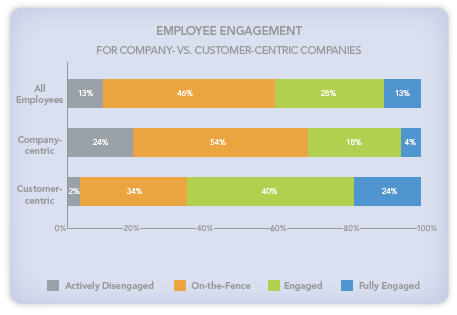Customer-centricity is increasingly being viewed by leaders as a strategic priority. Based on employee feedback from the PeopleMetrics 2011 Employee Engagement Trends report, this four-part series examines the seven practices that differentiate a customer-centric from a company-centric company.
In the 2010 IBM Report, "Capitalizing on Complexity: Insights from the Global Chief Executive Officer Study," 88% of CEOs worldwide and 95% of standout CEO’s picked “getting closer to the customer [as] the most important dimension to realize their strategy in the next five years.” Authors of this report recommend to readers: “Establish an unprecedented level of focus. Starting with the CEO, every employee in the organization must be hyper-focused on customers. Make customer value your number one value.”
But as anyone responsible for leading organizational change knows, it’s easier said than done. Customer-centricity is more than the flawed and overly simplistic approach of “the customer is always right.” Rather, being customer-centric changes the core practices that affect how a company relates to both customers and employees. In an article titled “Profitably Linking Employee Behavior to Customer Loyalty and Advocacy,” Michael Lowenstein highlights one study in particular that found, “70% of customer brand perception is determined by experiences with people.” Demonstrating that leadership prioritizes customer-centricity is heavily dependent on the front-line employees responsible for bringing a company’s brand to life.
The good news is that customer-centric practices do not only serve the interests of the customer, they also serve to improve the employee experience. In our 2011 Employee Engagement Trend report, we were interested in examining how an organization’s approach to customer-centricity impacts employees, and we found a compelling story. Using employee feedback, we were able to extract seven practices that differentiate customer-centric from company-centric companies. We will examine each of these practices in the following three parts of this series.

Customer-centric cultures consistently follow these seven practices and boast 6x the number of Fully Engaged employees and 12x fewer Actively Disengaged employees than their company-centered counterparts. These seven practices reveal how leaders are successfully communicating to employees that getting close to the customer is imperative to the future growth and success of the company.
~Janessa Lantz
Topics: Employee Experience, Customer Experience






